I am on a trip to two of the USA’s most interesting cities. Having spent a short time visiting old Boston, I board the train to New York. It is rather lovely travelling south. I had been advised earlier to “make sure to sit on the left of your coach” so as to see the views of the coast. Areas of marshes, harbours and clapboard houses come and go. Meanwhile, the train rapidly fills up. The voice over the tannoy system is deep and loud and clear: “There are 500 people on this train today. It is full. That is ten coaches. One seat per person folks.” Then: “Please remove everything on the seat next to you. That does include body appendages.” I check just to make sure. “Stamford, Stamford comin’ up.” Some while longer gazing through the window and eventually the announcement comes: “New York Penn Station in a few minutes. Café car closed. For restocking. Café car closed”.
New York is not a city for the faint hearted. I am a bit bemused when I eventually find my way out of Penn station into the crowds and traffic and noise. This is Manhattan, the most interesting area with most sights to see. I meet my American friend, Ellen, along with another friend of hers, whom I had met in Paris a few years before, in the hotel. Much jollity. We make our way to an American diner sort of place to eat. It is warm in New York, warmer than Boston. I have taken my shoes and socks off and replaced them with sandals. While we feast on moussaka and salads, of which there is an ample supply, the resident mosquitos feed on my ankles.
The bill comes. As I had found out in Boston, it takes a while to interpret such bills because the price on the menu is never the price you pay, due to taxes being added on afterwards. So one never quite knows what anything is going to cost. Potty or what? I could never quite get used to it. Another thing that I had not quite fully grasped is the American custom of tipping. The norm seems to be between about 15% and 20% for waiters, coffee servers, chamber maids, taxi drivers, guides, hotel doormen etc. etc. This is why Americans always seem so generous when they venture to UK. They tip all and sundry. “It is because the waiters and others have low salaries and expect to make it up in tips”, my friend explains. Of course, that is similar at home but we tip if we think the customer service warrants it – don’t we ? The norm is about 10% isn’t it? Or maybe I am just out of touch.
Manhattan
I had booked a tour in advance of the Statue of Liberty and Ellis Island. One has to inspect these historic sites if one goes to New York. Having learnt much about the revolution in the Boston area, no doubt it will be refreshing to learn about a later period, that of the immigrants flowing in to the country via Ellis Island in the early twentieth century. I take a taxi early next morning to the southern tip of Manhattan to meet the tour group at Castle Clinton in Battery Park. The taxi takes an hour. Hmmm. I had been advised against taking the metro. Could be dangerous. Anyway, after meeting the tour guide plus group at the Castle ‒ built to defend New York in around 1812 ‒ and gone through ‘airport’ security, we are herded onto one of the ‘Statue City Cruises’ boats, which takes some while with all the eager selfie snapping tourists. Wonderful weather means maximum number of participants on the tour. Eventually, we slip our mooring leaving the towering blocks and cacophony of Manhattan behind.
I stand on the stern of the boat gazing at the rapidly diminishing skyline of Manhattan. Spectacular it is too: mostly sky scrapers of different heights and widths with the occasional dome or pinnacle on top. The building that stands out most now, and is the tallest in New York, is the One World Trade Centre or ‘New Freedom Tower’, constructed out of steel and glass. It has a tall antenna on top, making the building 1,776 feet high, symbol of the date of the Declaration of Independence in 1776. It is located on the site of the original World Trade Centre, the twin towers, destroyed in the 9/11 attacks and is about 300 feet taller than the Empire State Building. From the boat one can see the River Hudson flowing around the west side of Manhattan and, on one of the city piers (City Pier A), an old low-rise building with a clock tower on the river’s edge is visible. This was constructed in the late 1800s and was the HQ of the Docks Department and NY Police Department. Now preserved and on the National Register of Historic Places, it is dwarfed by the high-rises.
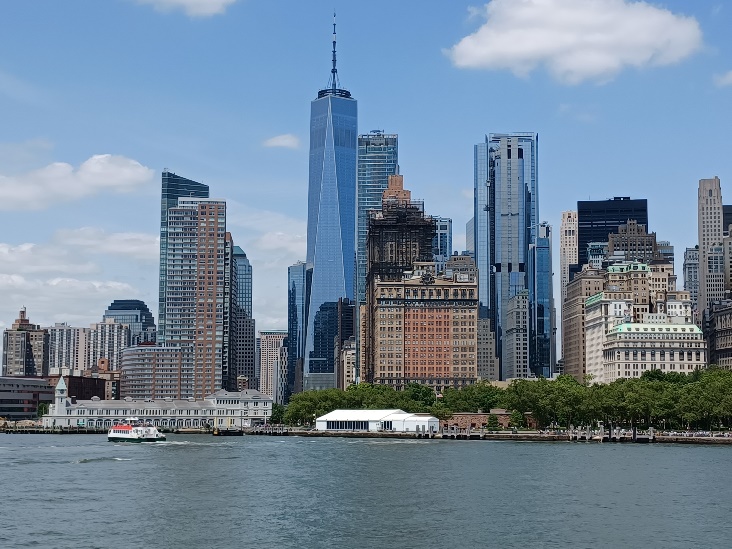
Statue of Liberty
As the Statue of Liberty hoves closer into view, one realises how huge the pedestal is upon which she stands. The pedestal was built on top of an old fort shaped as an eleven pointed star. As for the colossal statue itself, no matter how many times one has seen this on TV, it amazes. It looks awesome from the water. The statue was a gift from France to celebrate the 100th anniversary of the Declaration of Independence and was designed by the French sculptor, Frédéric-Auguste Bartholdi, out of 300 sheets of copper. It was shipped across the Atlantic in two hundred cases in 1885.
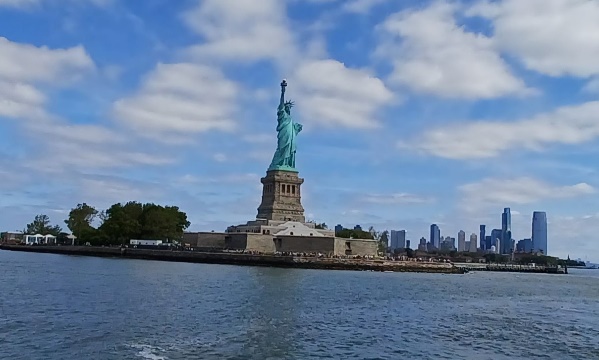
Our boat moors alongside the quay and our guide leads us out onto the pathway which goes around the statue. We are regaled with much information. “The seven spikes on her crown represent freedom’s light shining upon the seven continents and seven seas” she tells us. Its green colour is due to the oxidising of the copper. Apparently this patina is now as thick as the copper sheets themselves and protects the statue from weathering. Interesting. The only other colour is the yellow flame of the torch, “to light the way to freedom”. The official name of the statue is “Liberty Enlightening the World”.
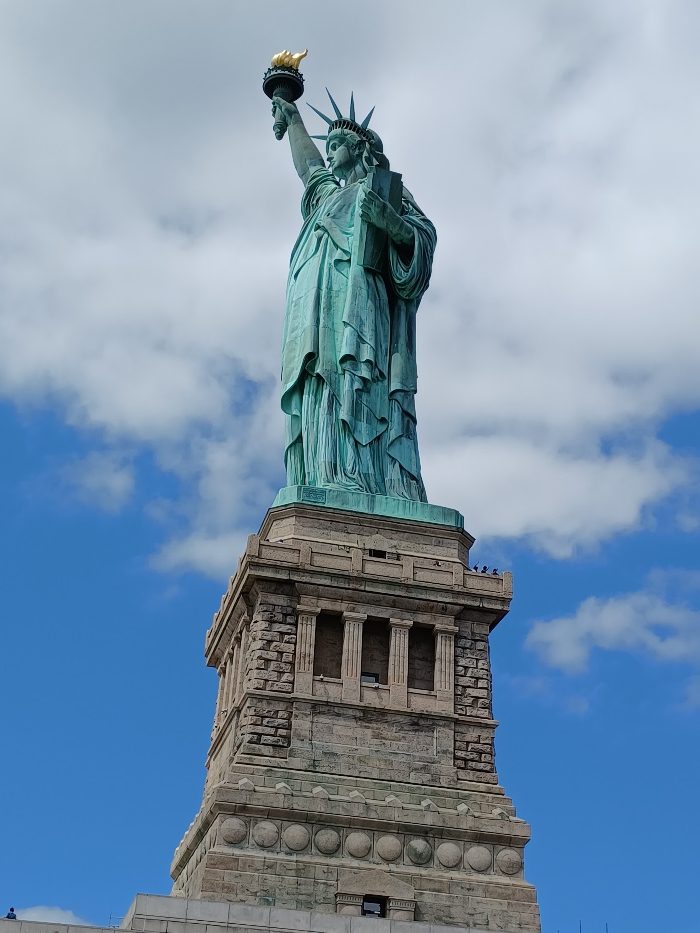
The museum behind the statue is very informative. A sign board tells us that the statue was so huge and heavy, with the outstretched arm holding the torch making it unbalanced, that it represented a significant engineering challenge to support it. Alexandre-Gustave Eiffel, he of Eiffel Tower fame, was brought in, and designed a wrought iron framework for it. There is a model of this framework here. Other exhibits include a replica of Liberty’s bronze face and the original torch.
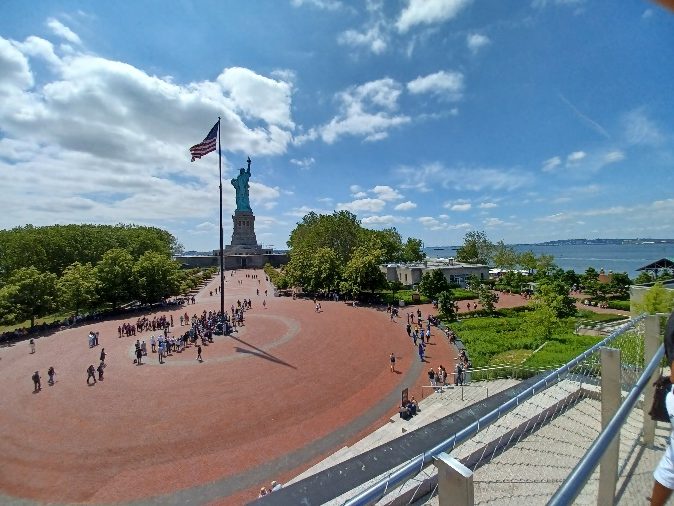
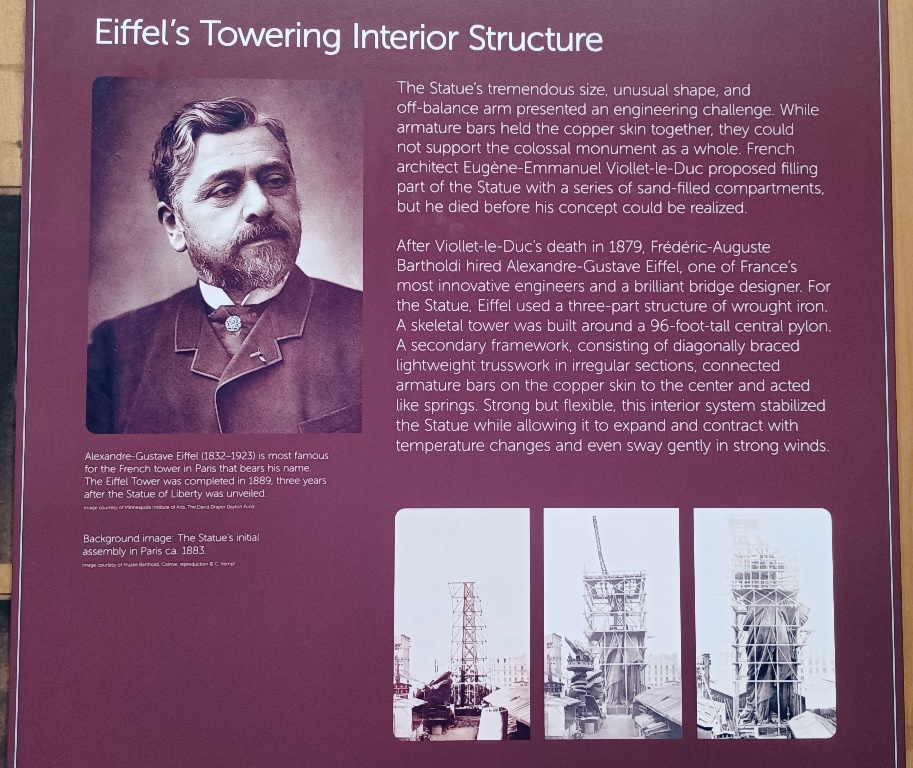
A lesser known fact that intrigued me, however, was information about the donation of a poem. On a bronze plaque, now inside the pedestal of the Liberty statue, is a sonnet by the American poet, Emma Lazarus, which was written in 1883 to help raise funds for the pedestal. Entitled ‘’The New Colossus’, it reads thus:
Not like the brazen giant of Greek fame,
With conquering limbs astride from land to land;
Here at our sea-washed, sunset gates shall stand
A mighty woman with a torch, whose flame
Is the imprisoned lightning, and her name
Mother of Exiles. From her beacon-hand
Glows world-wide welcome; her mild eyes command
The air-bridged harbor that twin cities frame.
“Keep, ancient lands, your storied pomp!” cries she
With silent lips. “Give me your tired, your poor,
Your huddled masses yearning to breathe free,
The wretched refuse of your teeming shore.
Send these, the homeless, tempest-tost to me,
I lift my lamp beside the golden door!”
An inspiring poem, and I had never even heard of it, although it has been cited by many in literature, films and songs since then.
Ellis Island
Fitting, then, to head now for the immigration centre of Ellis Island. The first immigrant filed through here in 1892 and the last in 1954 but the peak period was between 1900 and 1914. The immigration process for these ‘poor’ and ‘homeless’ ‘huddled masses’ seems to have been much more rosy then than it is for today’s immigrants. For, although some undesirables were denied access and about 10% were given a legal hearing, only 2% of the over twelve million immigrants passing through Ellis Island were sent back home. The waiting time for most before admittance to the USA was between three and five hours.
From the boat, I can make out the main building set in grounds surrounded by trees, above which four identical towers poke out. The American flag flies high and proud at the point where the seawall sticks out like a ship’s prow. We approach the jetty, the immigrants’ first disembarkation point after their long voyages, in America. The building is rather grand, French Renaissance style, built of red brick with white stone around arched windows and doors. Immigrants would have proceeded from the jetty straight towards its huge central portico within its symmetrical façade. I wonder how they felt. Relief, hope, fear, intimidation perhaps.
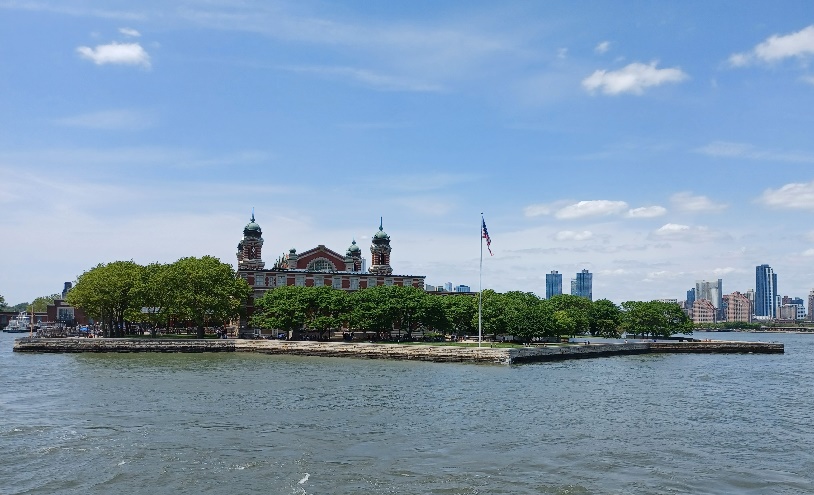
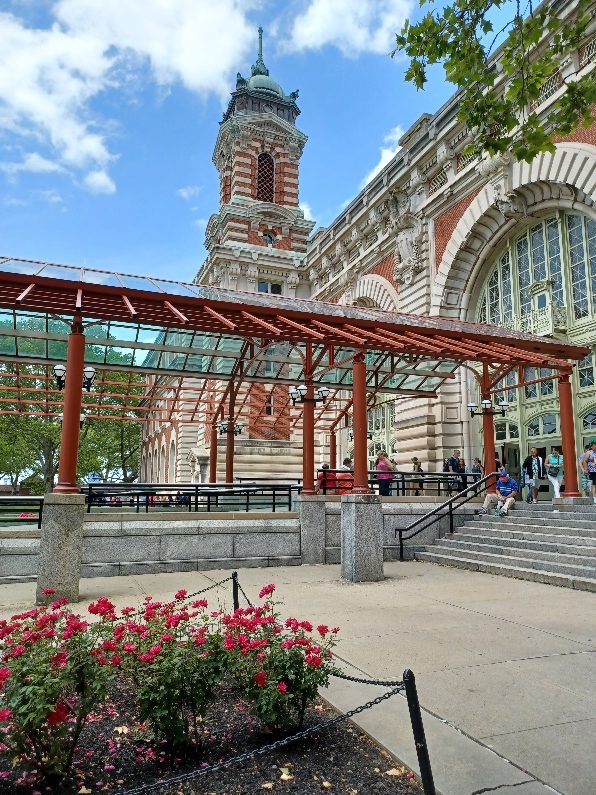
Our guide takes us to the side of the building next to the sea wall. She is determined to impart every ounce of her knowledge to the assembled throng. It is quite hot and I am thirsty. “Just one more thing”, and she continues her spiel. Just as I think she has finished, “and I just want to tell you about myself”. It turns out that her ancestors were immigrants and went through Ellis Island themselves. All very interesting but I need a drink. One lady walks off to sit in the shade of a tree. Others fidget. The guide is oblivious. Eventually, I slide off the wall, on which I have been perched for twenty minutes at least and, now released, head for the refreshments.
The exhibits include information about all aspects of the immigration process, including the ships in which the immigrants sailed, such as those run by the Holland America Line and Red Star Line; the dormitories in which some of those detained slept; and the massive Registry Room, the hall in which they waited in lines on the red tiled floor for medical inspections and cross examination of their documents. There are also exhibits of objects the immigrants brought with them. Fascinating and moving. I look down from the second storey gallery onto the great Registry room with its enormous curved tiled ceiling. Irving Berlin was in there once, Isaac Asimov, Claudette Colbert, Bob Hope ‒ to name a few. American flags hang down from each side over the tourists now swarming about below. I walk round the outside of the building, where leafy trees provide shade and pink flowers adorn borders, before boarding the boat back to Manhattan.
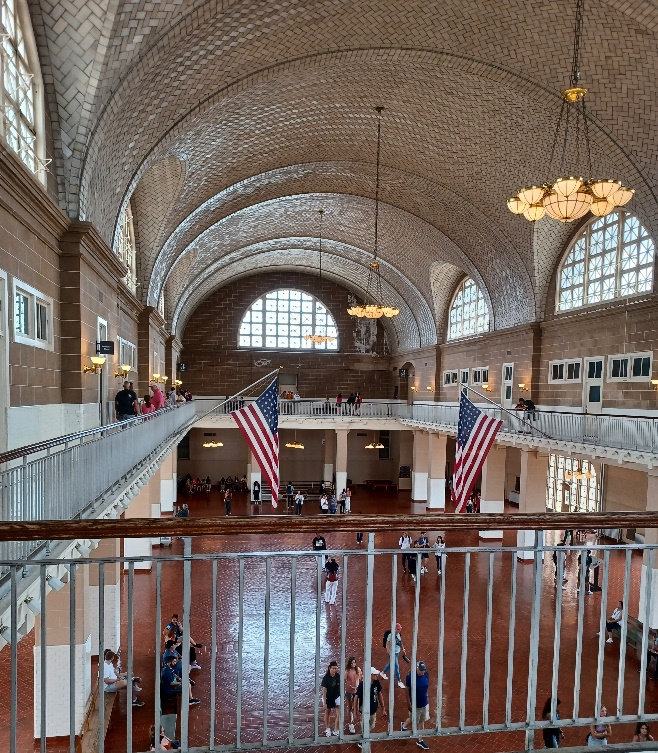
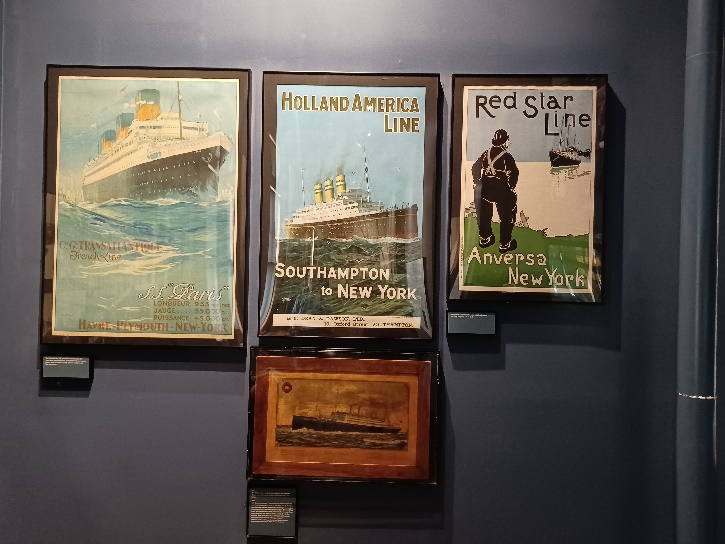
The skyscrapers grab one’s attention as one closes with the shore today, but the diminutive building with its clocktower on the City Pier A would have been what the immigrants saw in the early 1900s. They would also have noticed Trinity Church, with its 86 metre spire and cross, opposite Wall Street. After disembarking I head in that direction, first walking through the park past sellers of fruit – I buy some ‒ and handbags – I don’t buy some, and come across the National Museum of the American Indian. The Land of the Free was becoming less free for the indigenous peoples as the new peoples flooded in. I enter this imposing building with its columns and statuary, which once hosted the US Custom House. There are many exhibits here including pottery, feather headdresses, weapons and jewellery. I could spend much more time perusing them all. But I am suffering from information overload and want to see Trinity Church and the Wall Street Bull before heading back to the hotel.
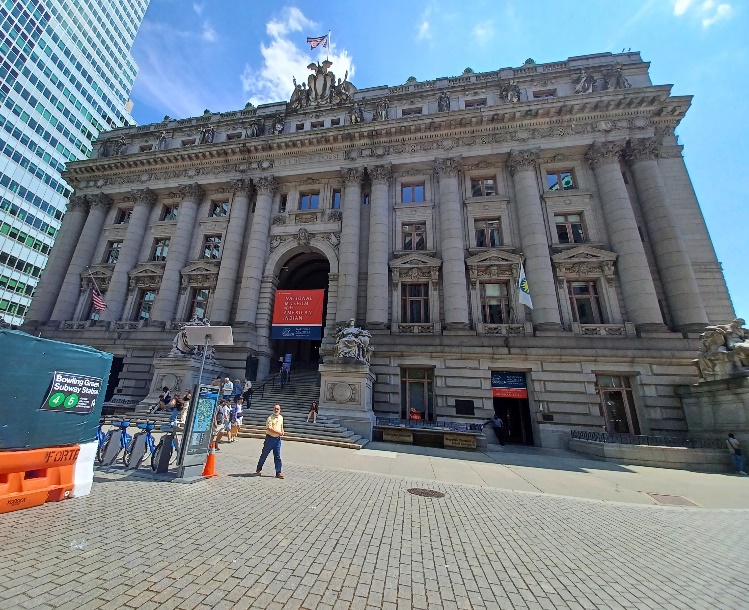
Trinity Church
Although Trinity Church is surrounded by skyscrapers, actually, because it faces Wall Street, one gets a good view of its stone west front and tower from the junction with Broadway. I had been hoping to ring the bells here, as I did in Boston, but didn’t. The church tower contains twelve change ringing bells. I go inside the church instead, having first put my bag through the X ray machine. It was built in the Gothic style, the church I mean, with pointed arches, vaulted ceiling covered by stone ribs and a stunning stained glass east window. I grab a pew and ponder for a while. During the 9/11 attacks, many people sought refuge inside.
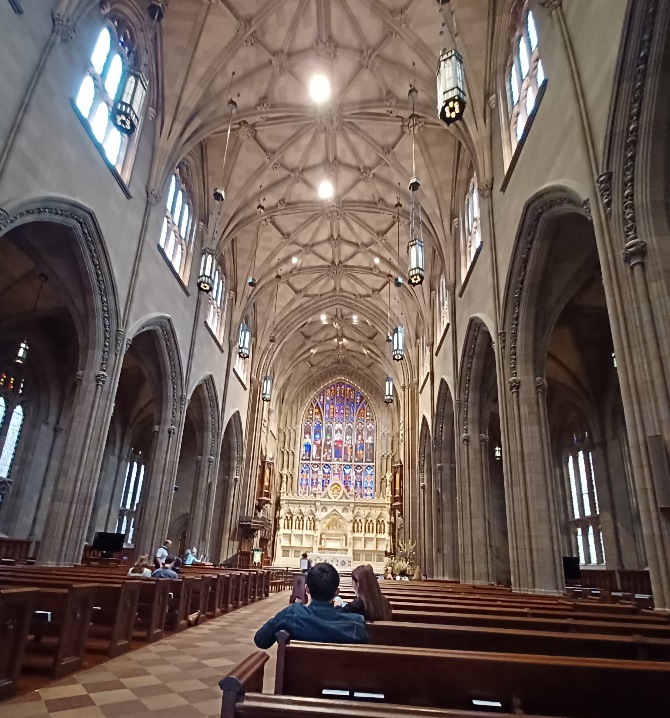
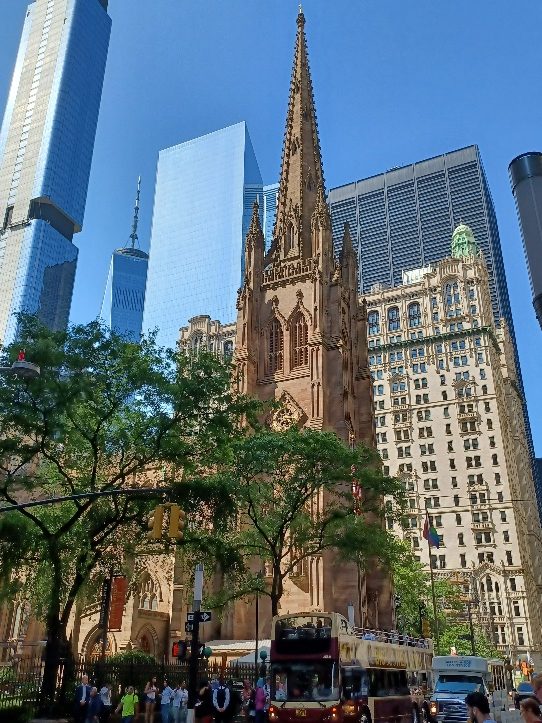
The Wall Street Bull
And so, from the sublime to the charging bronze bull, a sculpture by the Italian artist, Arturo di Modica. The story goes that the sculptor dropped off the bull, a mere 3.2 tonnes in weight and sixteen feet long, under the Christmas tree outside the New York Stock Exchange one early morning in December 1989. It was removed by police and impounded but the public liked it and made their feelings felt, so it was later installed as a temporary measure on Broadway, not far from Trinity Church. It became so popular with tourists that it is still there. A symbol of American capitalism to some, strength and virility to others, and fun for most. I watch as a youngster is placed on its broad bronze back and two Asian ladies giggle while photographing its backside with its burnished bronze balls dangling below.
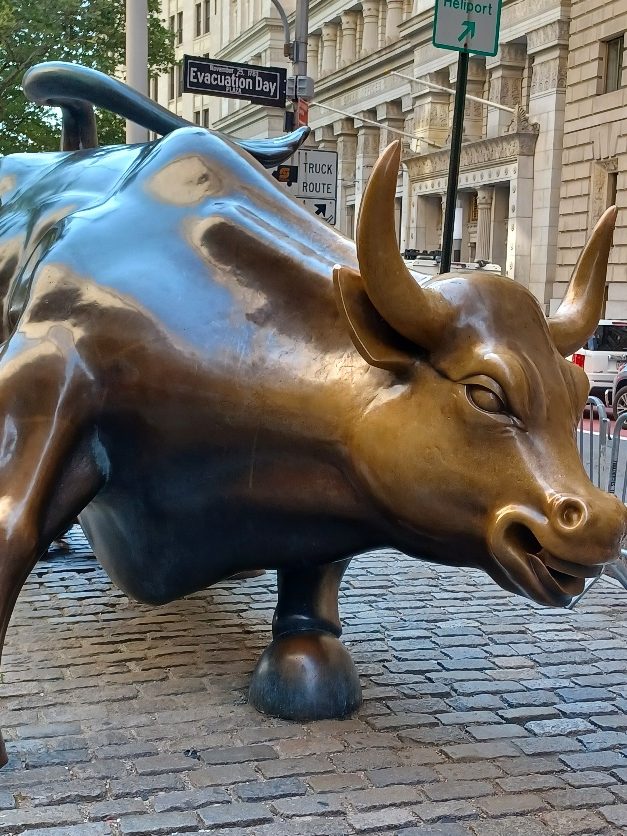
Times Square
I wonder how to get back to the hotel, which is just south of Central Park. Outside Trinity Church is a hop-on hop-off bus stop, by the side of which is a tout selling tickets. I buy a ticket for an outrageous price but it includes a small pair of red headphones, which one plugs in next to one’s seat. It makes for an interesting journey to listen to the two person commentary interspersed with Frank Sinatra, singing, naturally, ‘New York, New York’. The bus route is via the Hudson riverfront and various landmarks, ending in Times Square. I disembark amongst the neon flickering advertisements and a statue of Lieutenant Colonel Francis P Duffy (1871-1932), a Catholic priest and chaplain to the 165th US infantry. He had won many medals for his service to his country. Close by, in front of a Broadway ticket booth, someone is dressed as Spiderman alongside a fearsome looking gorilla (King Kong perhaps) and Minnie Mouse, while two news flashes spin around announcing the death of the former Italian PM, Silvio Berlusconi, and the heading of the footballer, Lionel Messi, to Inter Miami.
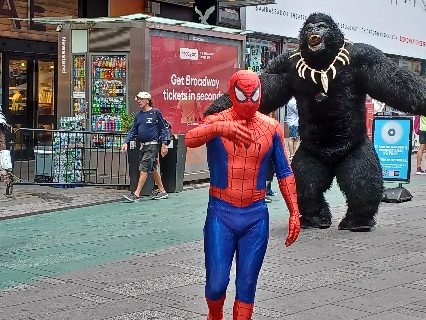
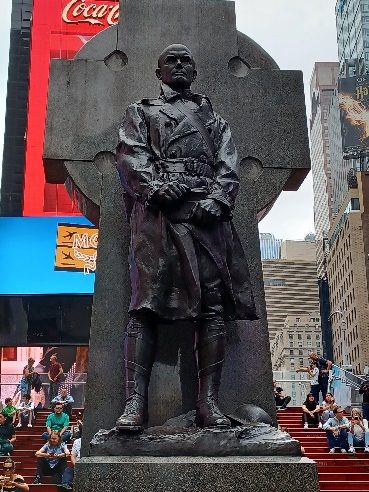
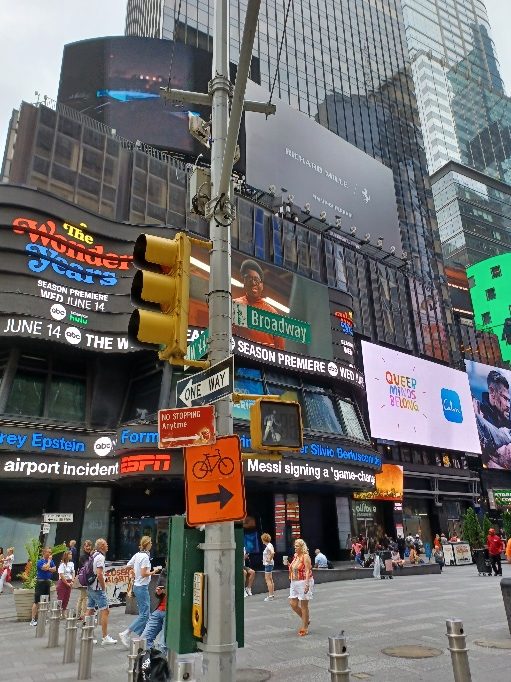
At the hotel I confab with my friends about the day’s trip. “Took a while to get a taxi”, I begin. “The doorman basically stood in the middle of the road until one stopped.” “I hope you gave him a good tip!” Indeed I did. We sup on steak, melt in the mouth, and fries, with some excellent red wine from Oregon in a smashing restaurant with paintings on the wall of what appear to be African tribesmen. Much recounting of events. A good day.
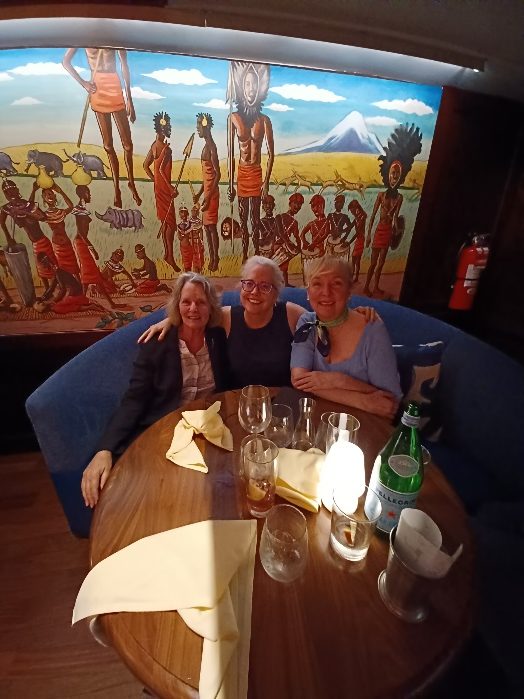
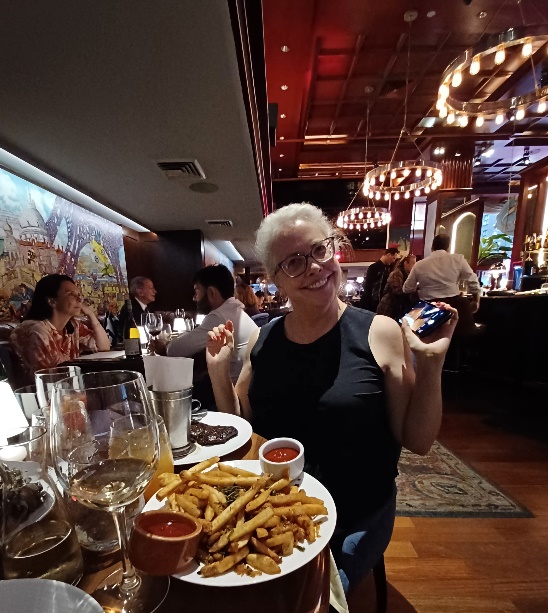
Memorial to the 9/11 Victims: ‘Ground Zero’
We wanted to pay homage to the nearly 3000 people who lost their lives in the 9/11 attacks on the World Trade Centre, so next day we head down to see the memorial in south Manhattan. Now known as ‘One World Trade Center’ or ‘Ground Zero’, the memorial incorporates the original footprints of the twin towers, which have waterfalls running down the sides, with a deeper square section in the middle of each. We talk to a volunteer at the site and ask him about the memorial. “The waterfalls represent tears,” he tells us, while the deeper area, towards which the water flows and disappears, represents “infinite sorrow”. The name of every person killed is engraved on the surrounding bronze panels. Many of those were firefighters and rescue workers. Someone has placed a huge wreath of red roses and carnations by the side of these names with a white ribbon commemorating all the responders ‘who made the supreme sacrifice’. A striking structure, ‘the Oculus,’ forms part of the surrounding buildings. It houses a shopping mall and transport hub and is built of white painted ribs which look like the wings of a dove.
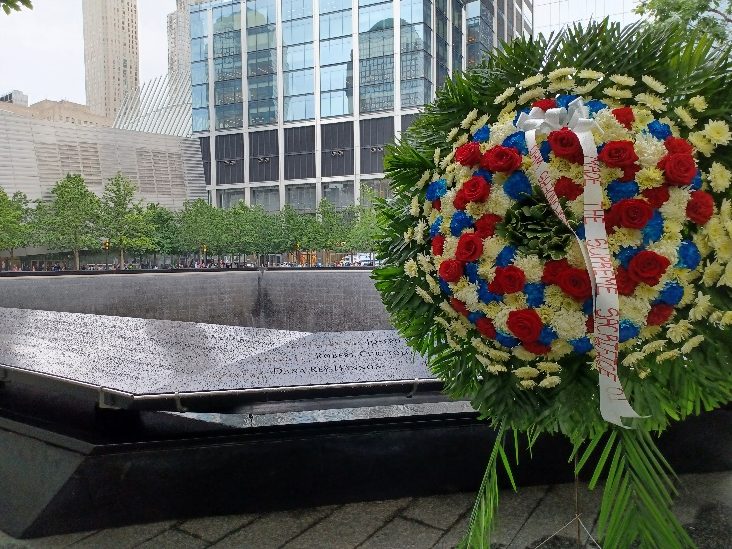
St Paul’s Chapel and the Bell of Hope
Near the memorial is St Paul’s Chapel, built in 1766 in the parish of Trinity Church as an extra church for the growing population. This chapel, despite being only 100 yards away from the twin towers, remained totally intact during the attacks, not even a pane of glass was broken. This was attributed to the trees, in particular a giant sycamore, that protected it, earning St Paul’s the nickname ‘The Little Chapel that Stood’. The church had also survived a great fire in 1776 during the revolutionary war. Two miracles? During and after 9/11, St Paul’s became a sanctuary for the public and a place for recovery workers, caterers, counsellors and other volunteers to help out day and night.
In front of St Paul’s cemetery is a bell, known as ‘The Bell of Hope,’ placed there on the first anniversary of the attacks, and presented by the Lord Mayor of London and Archbishop of Canterbury to the people of New York. The bronze plaque on its pedestal tells us that every year since then, 2002, the Bell has been rung on September 11th ‘symbolizing the triumph of hope over tragedy’. It was cast in the Whitechapel foundry in London, the same foundry that cast the Liberty Bell in Philadelphia, a symbol of American independence. We go inside the Chapel, which is bright and airy with its white columns and arched windows. George Washington had a pew here and attended service after his inauguration in 1789. Above his pew is a painting of the Great Seal of the United States portraying the country’s coat of arms with its eagle and 13 stripes.
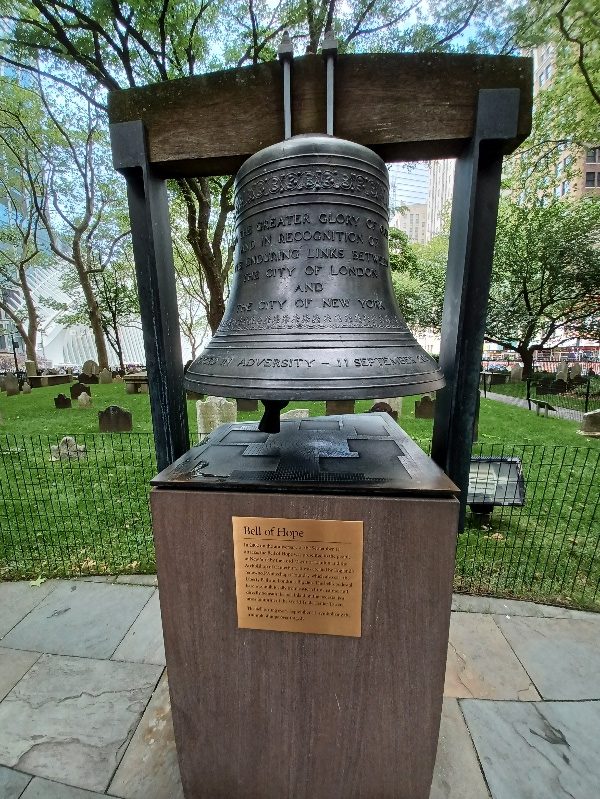
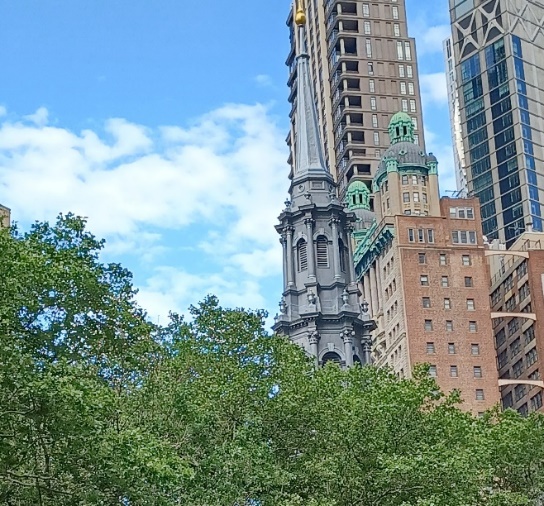
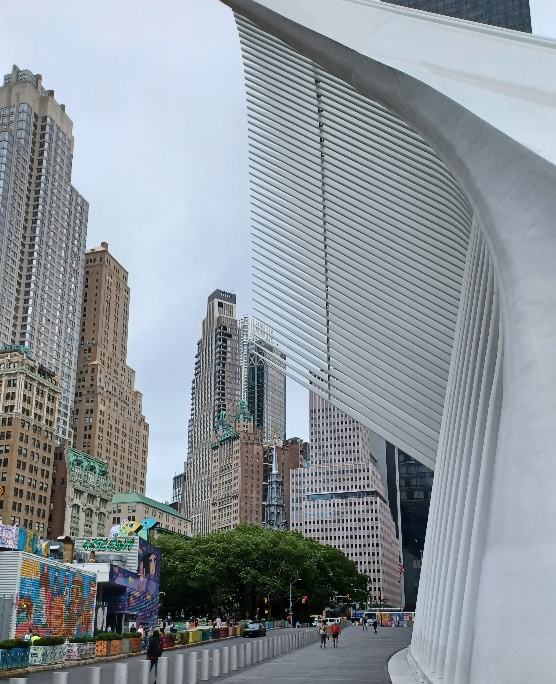
Brooklyn Bridge
After all this, a bit of fresh air and exercise is called for, so off we walk towards the majestic Brooklyn Bridge, a suspension bridge completed by the cities of New York and Brooklyn in 1883, which crosses the East river between Manhattan and Brooklyn. It is almost a kilometre along the broad wooden promenade above the road to the granite central tower with its gothic arches. One gets a different perspective of New York from here, gazing out at the skyline between the huge steel ribs and cables.
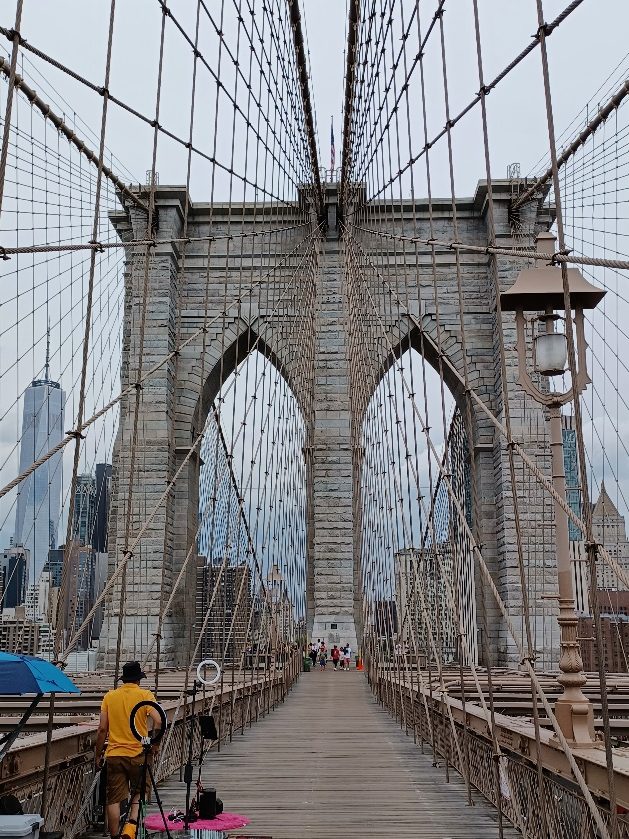
Carnegie Hall
I have a couple of more days to spend in New York. Not like being on a tour when I would probably have had a mere guided tour of the city in the morning and an afternoon free. Time to visit some of the historic buildings, stimulating museums and galleries in slow time. Near our hotel is Carnegie Hall, built by the Scottish immigrant, Andrew Carnegie, as a concert venue. We partake of a tour given by an elderly and erudite volunteer. Carnegie made his money as a steel manufacturer, we are told, and made so much of the stuff that he became a philanthropist later in life. Thus, the founding of this grand concert hall, its façade decorated with arches and arcades, which opened in 1891.
The venue welcomes all genres of music, driven by the wish to give everyone a chance to perform on a world stage, from Gustav Mahler to Louis Armstrong to Bob Dylan and The Rolling Stones. Politicians and intellectuals such as Theodore Roosevelt and Mark Twain respectively have also appeared. Photographs of past performers adorn the walls, the corridors and stairways. All very impressive. Plush red seats contrast with the bright white stage upon which we gaze from a balcony. It would be easy to topple over, I muse, onto those red seats below, as there are no extra handrails between a person in the vertical and the void. Abstaining from alcohol might be judicious if placed up here.
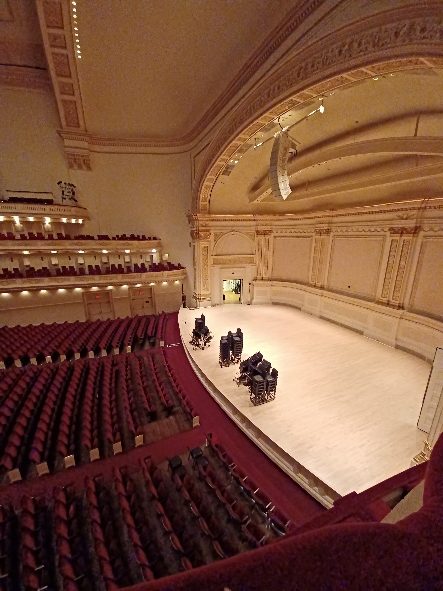
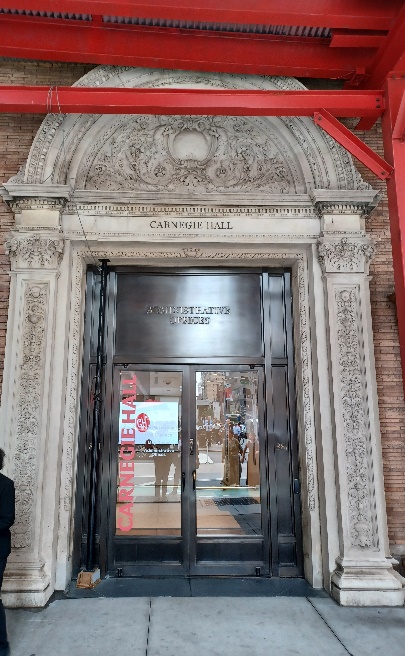
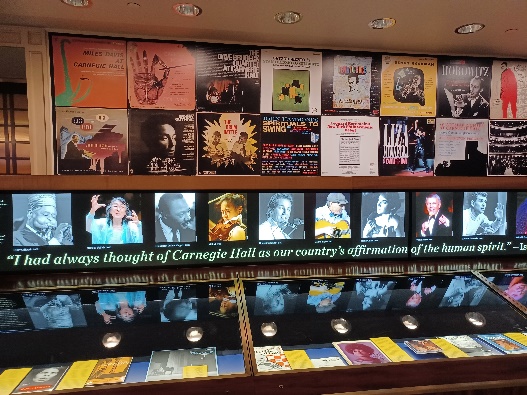
MOMA and the MET
I visit MOMA, the Museum of Modern Art, and see Salvador Dalí’s ‘hallucinatory dreamscape,’ as it is described, the one with the floppy clocks. And works by Picasso and Magritte, as well as an interesting painting by Peter Blume called ‘The Eternal City’, featuring Mussolini ‘depicted as a deranged jack-in-the-box’ amongst Rome’s ruins; and a peculiar stuffed parrot by Joan Miró. I go up to the top of the Rockefeller Center, designated a National Historic Landmark in 1987, and see the view over New York, including the Empire State Building, Central Park and a diminutive St Patricks’ Cathedral.
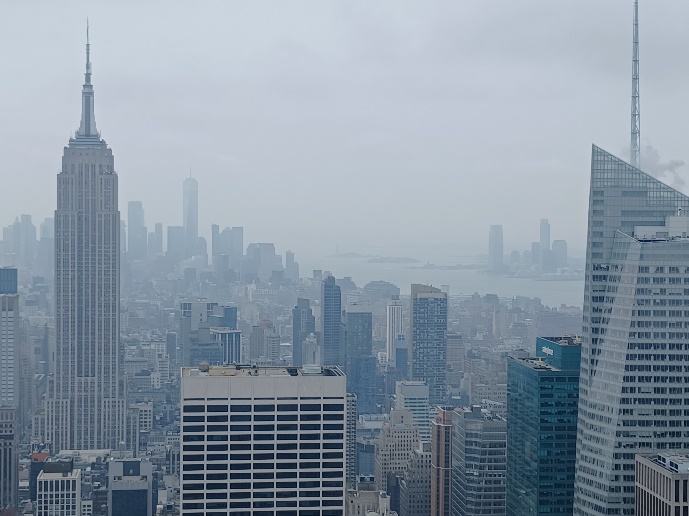
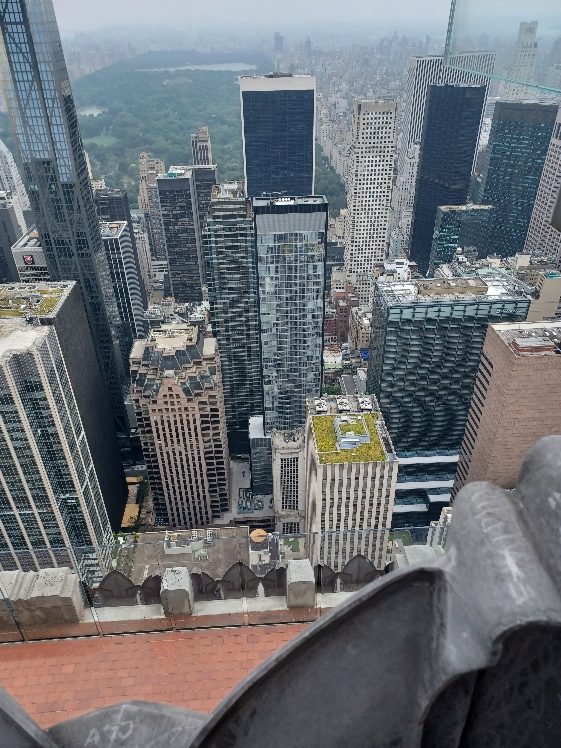
The Metropolitan Museum of Art (MET ), however, is highest on the list of places to visit. The route from the hotel is via Central Park, a very large area bang in the centre of Manhattan with many paths, woods, lakes, horses and carriages taking tourists for rides, children’s playgrounds, ice cream vans ‒ you know the sort of thing. Families are spread about on the dry grass of Sheep Meadow, kiddies scramble over a large sculpture of Alice in Wonderland atop a toadstool with the Mad Hatter and the White Rabbit, and a jazz band plays.
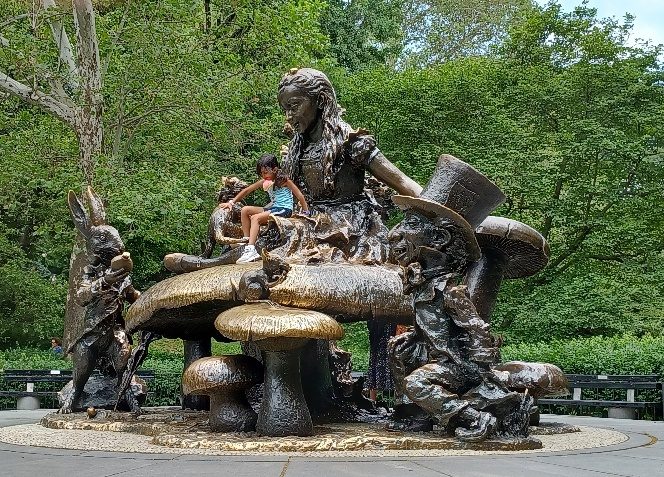
The MET itself projects into Central Park in which, just behind, is an obelisk from Egypt, Cleopatra’s Needle. This is Central Park’s oldest outdoor monument apparently, given by the Egyptian government to America in 1881 in exchange for aid. London has its own Cleopatra’s Needle too on the banks of the Thames. The MET itself is built of stone and broad steps lead up to its grand entrance.
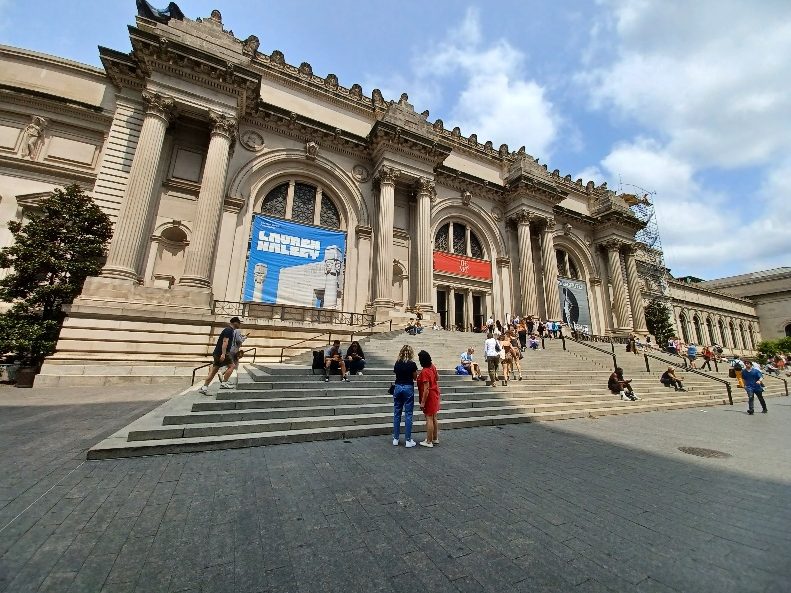
Being in the US of A, I feel I should brush up my knowledge of American artists. Not that I possess any knowledge if truth be known. Anyway, the fact that there are two million artworks in the MET means one has to be selective. It takes a while to find the American wing, what with so many areas being closed off right now, but eventually I enter a room to behold a huge painting of ‘Washington Crossing the Delaware’ by Emanuel Leutze. It fills up the whole of one wall. In it, George Washington is portrayed standing on the prow of a boat, his men rowing through a river of icebergs on the way to launch a surprise attack on German soldiers (the Hessians), which the British had hired to help. Other boats are behind him, one with a few horses. The year was 1776. The painting became extremely popular as it appealed to nationalist sentiments among other things.
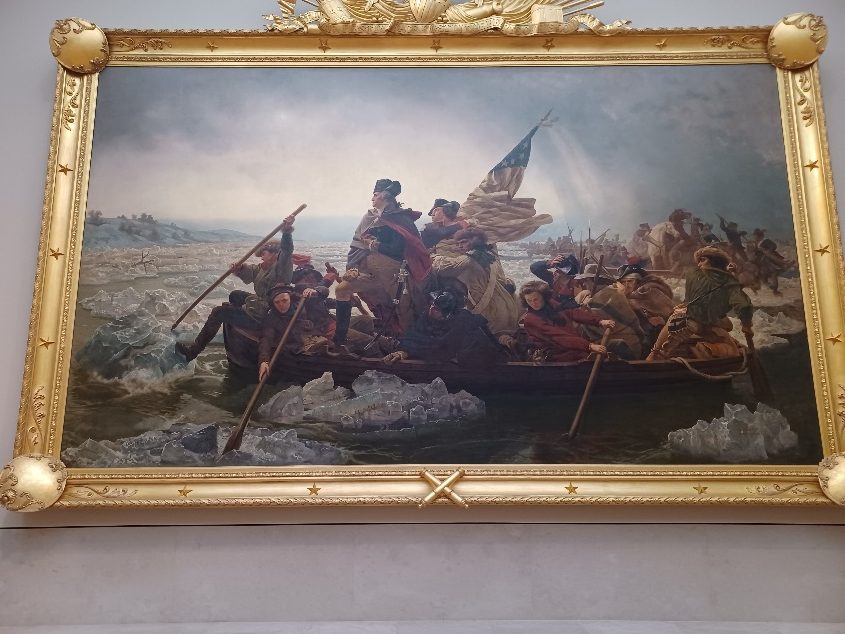
Some while is spent wandering through the Egyptian section with its temple of Dendera, given to the American people by grateful Egyptians for their help in saving monuments from Lake Nasser’s way before the building of the Aswan High Dam (see the Egypt article). Then comes a Chinese garden, modelled on the Master of Nets Garden in Suzhou, China, with its weird shaped rocks, pools, and pavilions; elsewhere Roman sculptures and Byzantine mosaics. But I like the paintings best. The gorgeous one by Frederic Edwin Church of the Parthenon in Athens in all its faded glory only makes one hunger for more travels to exotic places.
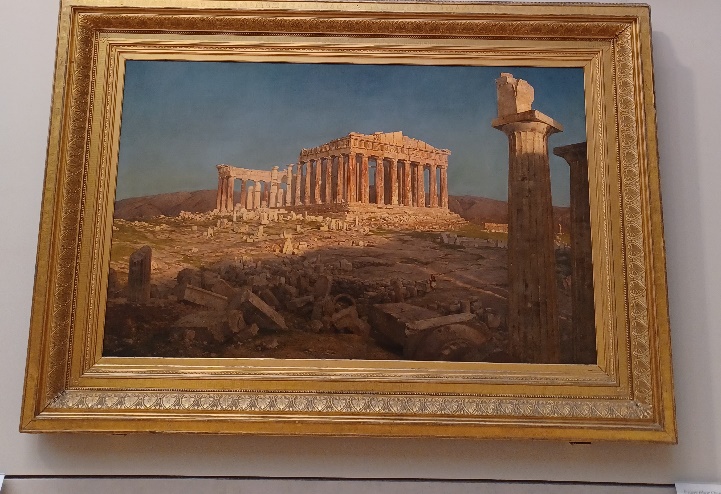

Leave a Reply